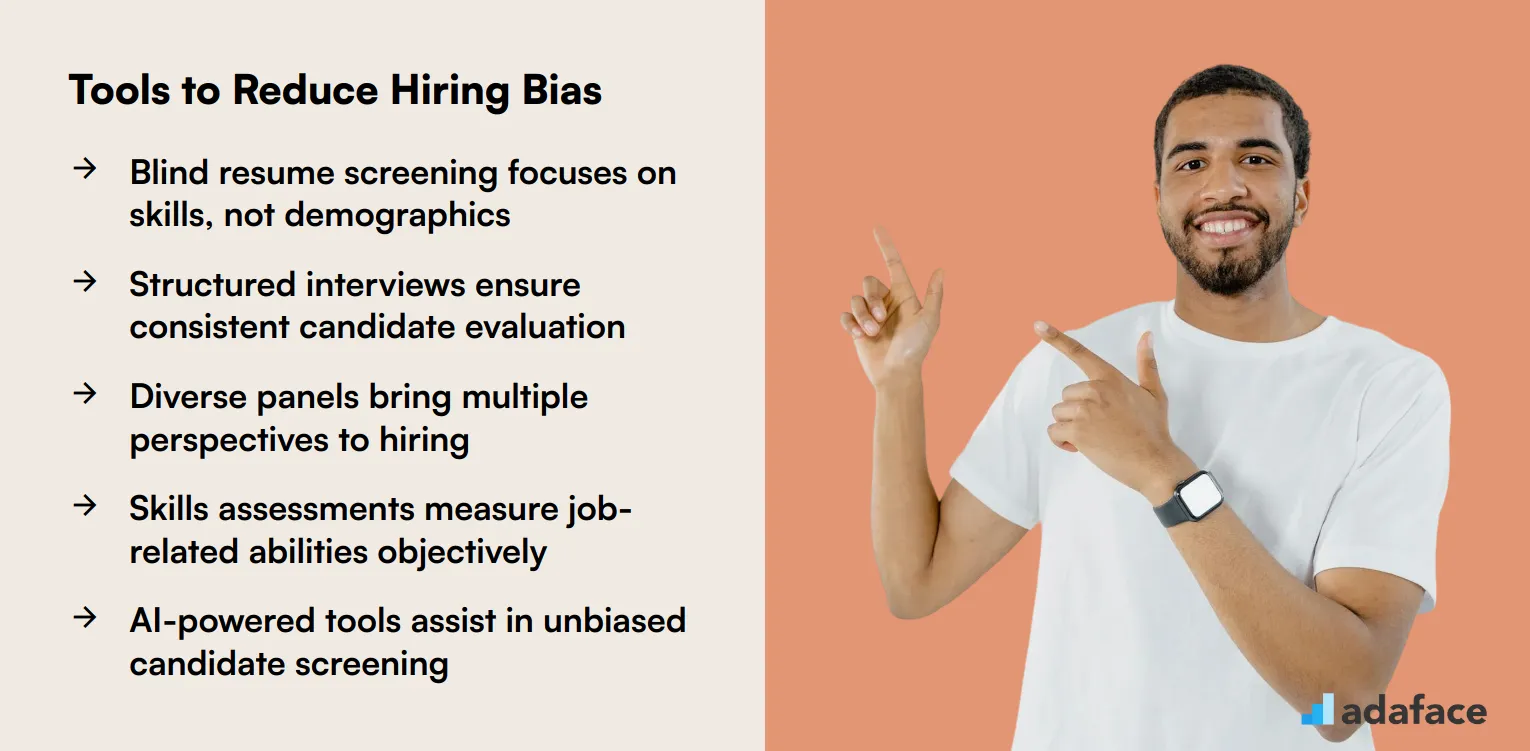Unconscious bias can significantly impact hiring decisions, leading to a less diverse workforce and potentially missing out on top talent. By understanding and addressing these biases, recruiters can create a more equitable and effective hiring process.
This guide explores common types of bias in recruitment, strategies for mitigation, and tools to promote unbiased hiring. We'll also discuss training programs and methods to measure the effectiveness of bias reduction efforts.
Table of contents
Understanding Bias in Recruitment
Bias in recruitment refers to unconscious or conscious prejudices that influence hiring decisions. These biases can lead to unfair treatment of candidates based on factors unrelated to their qualifications or job performance potential.
Common types of bias include affinity bias, where recruiters favor candidates similar to themselves, and confirmation bias, where interviewers seek information that confirms their initial impressions. Other forms include halo effect, stereotyping, and gender or racial bias.
Biases can manifest at various stages of the recruitment process, from resume screening to interviews and final selection. They may result in overlooking qualified candidates, perpetuating workplace homogeneity, and hindering diversity efforts.
Recognizing and addressing bias is crucial for creating fair and effective hiring practices. Implementing structured interviews, diverse hiring panels, and objective assessment methods can help mitigate the impact of bias in recruitment.
Regular training and awareness programs can educate recruiters and hiring managers about their own biases. Utilizing technology and data-driven approaches can also support more objective decision-making in the hiring process.
Common Types of Bias in Hiring
Bias in hiring can significantly impact the diversity and quality of your workforce. Understanding common types of bias is the first step towards creating a fair and inclusive recruitment process.
Affinity bias leads recruiters to favor candidates who are similar to themselves in background, interests, or experiences. This can result in a homogeneous team lacking diverse perspectives and skills.
Confirmation bias occurs when interviewers seek information that confirms their preexisting beliefs about a candidate. It can cause recruiters to overlook important qualifications or red flags that don't align with their initial impression.
Halo effect happens when a single positive trait influences the overall evaluation of a candidate. Conversely, horn effect is when one negative characteristic overshadows a candidate's other qualifications.
Gender bias can manifest in job descriptions, interview questions, or evaluation criteria that favor one gender over others. This bias can lead to unequal representation and missed opportunities for qualified candidates.
Age bias involves making assumptions about a candidate's abilities or cultural fit based on their age. It can result in overlooking experienced professionals or underestimating the potential of younger applicants.
Recognizing these biases is crucial for developing strategies to mitigate their impact on hiring decisions. By addressing these common pitfalls, organizations can create a more equitable and effective recruitment process.
Strategies for Mitigating Bias
Mitigating bias in recruitment requires a multi-faceted approach. Here are some effective strategies to reduce bias and promote fairness in your hiring process:
Implement structured interviews with standardized questions for all candidates. This approach ensures consistency and allows for objective comparison of responses across applicants.
Use blind hiring techniques to remove identifying information from resumes and applications. Focusing solely on qualifications and skills helps reduce unconscious biases related to demographics.
Provide bias awareness training for all interviewers and decision-makers involved in hiring. Educating your team about common biases and their impact can help them recognize and mitigate their own biases.
Leverage diverse hiring panels to bring multiple perspectives to the evaluation process. Including team members from different backgrounds can help counteract individual biases and lead to more balanced assessments.
Utilize skills-based assessments to objectively evaluate candidates' abilities. Focusing on job-related competencies rather than subjective impressions helps level the playing field for all applicants.
Regularly audit your hiring data and outcomes to identify potential bias patterns. Analyzing metrics like diversity of applicant pools and hire rates can reveal areas for improvement in your recruitment process.
Tools and Techniques for Unbiased Hiring
Unbiased hiring is crucial for creating diverse and inclusive workplaces. Here are some effective tools and techniques to help recruiters and hiring managers mitigate bias in their hiring processes:
Blind resume screening removes identifying information from resumes to focus on skills and qualifications. This technique helps eliminate unconscious bias related to factors like name, gender, age, or educational background.
Structured interviews use a standardized set of questions and evaluation criteria for all candidates. This approach ensures consistency and reduces the impact of subjective impressions on hiring decisions.
Diverse interview panels bring multiple perspectives to the evaluation process. Including team members from different backgrounds can help counterbalance individual biases and provide a more well-rounded assessment of candidates.
Skills assessments offer objective measures of a candidate's abilities and job-related competencies. These tests can provide valuable data to supplement resume reviews and interviews, helping to focus on actual capabilities rather than assumptions.
AI-powered tools can assist in various stages of the hiring process, from resume screening to interview analysis. While these tools should be used carefully to avoid perpetuating existing biases, they can help identify qualified candidates more objectively.
Regular bias awareness training for all involved in the hiring process is essential. This training helps recruiters and hiring managers recognize and mitigate their own unconscious biases, leading to fairer evaluations of candidates.

Training and Awareness Programs
Training and awareness programs play a significant role in mitigating bias in recruitment. These programs are designed to educate recruiters and hiring managers about the different types of biases that can influence their decisions, such as unconscious bias. By understanding these biases, professionals can make more informed and fair decisions during the hiring process.
Effective training programs often include workshops, seminars, and interactive sessions. These activities encourage participants to recognize their own biases and learn strategies to counteract them. Additionally, role-playing exercises can help recruiters practice unbiased interviewing techniques in a controlled environment.
Awareness programs also focus on fostering a culture of inclusivity within the organization. By promoting diversity and inclusion, these programs aim to create a more welcoming workplace for candidates from all backgrounds. This not only improves the candidate experience but also enhances the overall talent pool.
Ongoing training and awareness initiatives are crucial for reinforcing bias mitigation strategies. Regular refreshers ensure that recruitment teams remain vigilant and committed to fair hiring practices. Moreover, integrating these programs into the broader talent management strategy can lead to more sustainable outcomes in diversity and inclusion efforts.
Measuring and Monitoring Bias Reduction Efforts
To effectively measure and monitor bias reduction efforts in recruitment, it's important to establish clear metrics and benchmarks. These metrics can include diversity in candidate pools, interview panels, and the overall hiring process.
Regularly reviewing these metrics allows organizations to identify trends and make necessary adjustments. For instance, tracking the applicant-to-hire ratio can provide insights into potential biases at different recruitment stages.
Implementing feedback mechanisms such as surveys can also help gather insights from candidates and employees. This feedback is crucial in understanding where bias may still exist and how it can be further reduced.
Using technology, like recruitment analytics, can offer deeper insights into the effectiveness of bias mitigation strategies. These tools can analyze large data sets to highlight areas where bias might be impacting hiring decisions.
Finally, fostering a culture of continuous learning and improvement is key. Encouraging open discussions and training on unconscious bias can help maintain momentum in bias reduction efforts.
Conclusion: Building a Fair and Inclusive Hiring Process
Recognizing and addressing bias in recruitment is a continuous journey. By understanding common biases, implementing strategies, and using the right tools, we can create a more equitable hiring process.
Regular training and awareness programs help keep bias mitigation at the forefront of our recruitment efforts. Measuring and monitoring our progress ensures we're on the right track and allows us to make necessary adjustments.
Remember, the goal is not perfection, but constant improvement. By committing to bias mitigation, we can build stronger, more diverse teams that drive innovation and success.
Bias Mitigation FAQs
Common biases in recruitment include:
- Affinity bias: Favoring candidates similar to oneself
- Halo effect: Letting one positive trait influence overall perception
- Confirmation bias: Seeking information that confirms preexisting beliefs
- Gender and racial bias: Making judgments based on demographics
Recruiters can reduce bias by:
- Using structured interviews with standardized questions
- Implementing blind resume screening
- Diversifying the hiring panel
- Setting clear, objective criteria for evaluation
- Utilizing skills-based assessments
Helpful tools for bias mitigation include:
- AI-powered resume screening software
- Skill assessment platforms
- Diversity and inclusion analytics tools
- Bias-detection software for job descriptions
- Structured interview guides and scorecards
Companies can measure bias reduction by:
- Tracking diversity metrics in applicant pools and hires
- Analyzing promotion and retention rates across demographics
- Conducting regular pay equity audits
- Gathering feedback through anonymous employee surveys
- Monitoring changes in company culture and inclusion scores

40 min skill tests.
No trick questions.
Accurate shortlisting.
We make it easy for you to find the best candidates in your pipeline with a 40 min skills test.
Try for freeRelated terms



